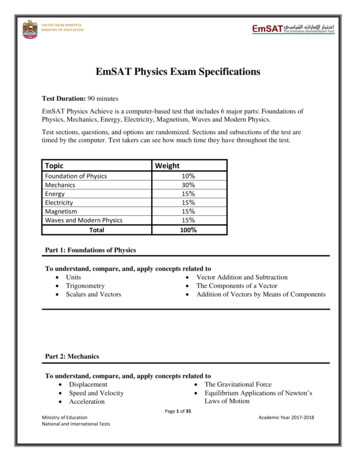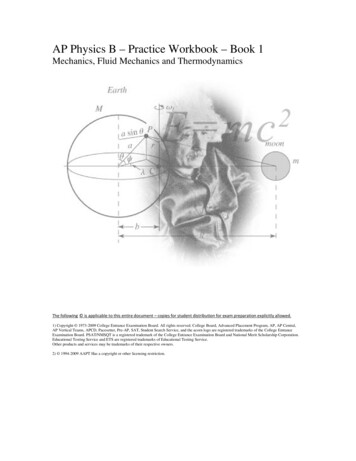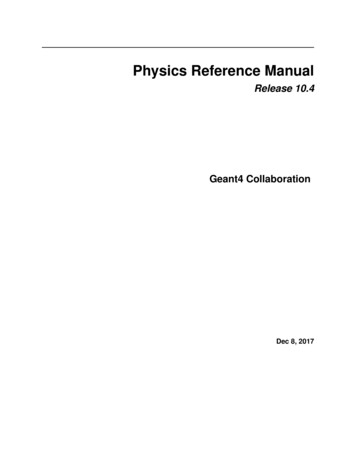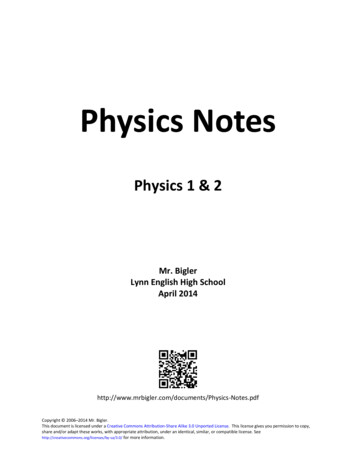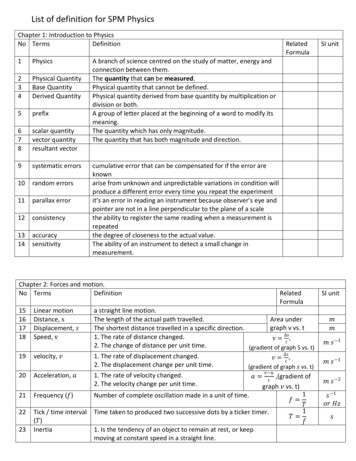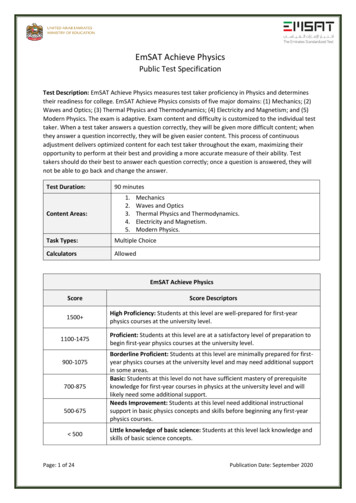
Transcription
EmSAT Achieve PhysicsPublic Test SpecificationTest Description: EmSAT Achieve Physics measures test taker proficiency in Physics and determinestheir readiness for college. EmSAT Achieve Physics consists of five major domains: (1) Mechanics; (2)Waves and Optics; (3) Thermal Physics and Thermodynamics; (4) Electricity and Magnetism; and (5)Modern Physics. The exam is adaptive. Exam content and difficulty is customized to the individual testtaker. When a test taker answers a question correctly, they will be given more difficult content; whenthey answer a question incorrectly, they will be given easier content. This process of continuousadjustment delivers optimized content for each test taker throughout the exam, maximizing theiropportunity to perform at their best and providing a more accurate measure of their ability. Testtakers should do their best to answer each question correctly; once a question is answered, they willnot be able to go back and change the answer.Test Duration:90 minutesContent Areas:1.2.3.4.5.MechanicsWaves and OpticsThermal Physics and Thermodynamics.Electricity and Magnetism.Modern Physics.Task Types:Multiple ChoiceCalculatorsAllowedEmSAT Achieve PhysicsScore1500 1100-1475900-1075700-875500-675 500Page: 1 of 24Score DescriptorsHigh Proficiency: Students at this level are well-prepared for first-yearphysics courses at the university level.Proficient: Students at this level are at a satisfactory level of preparation tobegin first-year physics courses at the university level.Borderline Proficient: Students at this level are minimally prepared for firstyear physics courses at the university level and may need additional supportin some areas.Basic: Students at this level do not have sufficient mastery of prerequisiteknowledge for first-year courses in physics at the university level and willlikely need some additional support.Needs Improvement: Students at this level need additional instructionalsupport in basic physics concepts and skills before beginning any first-yearphysics courses.Little knowledge of basic science: Students at this level lack knowledge andskills of basic science concepts.Publication Date: September 2020
EmSAT Achieve PhysicsPublic Test SpecificationAppendix 1: Content AreasBelow are the major sections and related content specifications that grade 12 students should be ableto demonstrate mastery of in order to meet the expectations of this test.I.MechanicsThis domain measures examinee understanding on Translational Motion, Rotational Motionand Fluids Mechanics.A. Translational MotionExaminee should be able to analyze, interpret and describe the motion of objects in 1D and 2DTranslational Motion in term of kinematics and dynamics laws and laws of conservation:conservation of energy and conservation of momentum.A.1 Examinee should be able to apply all the laws of kinematics and dynamics in order tointerpret, analyze and describe translational motion for objects in different arrangements andsituations.This section may include:1. 1D Translational Motion Kinematics Quantities.2. Kinematics Equations in Uniform Linear Motion.3. Newton's Laws of Motion.4. Universal Gravitation and Kepler’s laws of Planetary Motion.5. 2D Translational Motion Kinematics Quantities.6. Projectile Motion.7. Uniform Circular Motion and Satellite Motion.A.2 Examinee should be able to evaluate the work done by a force or multiple forces on agiven system to the changes in that system total energy and power and apply the law ofconservation of energy to describe, analyze and solve problems that are difficult to analyzeusing Newton’s Laws of Motion. This section may include:1. Work done by constant or varying force.2. Energy.3. Power.4. Conservation of Energy.A.3 Examinee should be able to use the law of conservation of 1D and 2D linear momentum todescribe, analyze and solve the motion of situations that are difficult to analyze usingNewton’s Laws of Motion such as collisions and explosions in 1D and 2D. This section mayinclude:1. Center of Mass.2. Linear Momentum.3. Impulse.4. Conservation of linear Momentum.5. Collisions.Page: 2 of 24Publication Date: September 2020
B. Rotational MotionExaminee should be able to analyze, interpret and describe the rotational motion of anextended rigid object about a fixed axis in term of kinematics and dynamics laws and laws ofconservation: conservation of angular energy and conservation of angular momentum.B.1 Examinee should be able to apply all the laws of kinematics and dynamics in order tointerpret, analyze and describe rotational motion of an extended rigid object about a fixedaxis in different arrangements and situations. This section may include:1. Rotational Motion Kinematics Quantities2. Moment of Inertia.3. Torque.4. Newton’s Second Law for Rotation and Static Equilibrium.B.2 Examinee should be able to relate the work done by a torque or multiple torques on agiven system to the changes in that system total angular energy and use the law ofconservation of angular energy to describe, analyze and solve problems that are difficult toanalyze using Newton’s Laws of Motion. This section may include:1. Work Done by constant or varying Torque.2. Angular Energy and Conservation of Angular Energy.3. Angular Momentum and Conservation of angular Momentum.C. Fluids MechanicsExaminee should be able to analyze, interpret and describe the properties of fluids at rest andin motion using fluids mechanics laws such as Pascal's Principle, Archimedes’ Principle andBernoulli’s Equation.C.1 Examinee should be able to analyze, predict and describe the properties of fluids at rest.This section may include:1. Pascal’s Principle.2. Archimedes’ Principle and Law of Floatation.C.2 Examinee should be able to analyze, predict and describe the properties and the behaviorof ideal fluids in motion. This section may include:1. Fluids Flow2. Bernoulli’s EquationPage: 3 of 24Publication Date: September 2020
II.Waves and OpticsThis domain measures examinee understanding of oscillations, waves (Mechanical waves andelectromagnetic waves) and optics (geometric optics and physical optics).A. WavesExaminee should be able to analyze, interpret and describe different types of oscillations andexplain how repeated oscillations cause periodic waves (travelling wave or standing waves)with unique properties and characteristics.A.1 Examinee should be able to distinguish and analyze different types of oscillations: idealoscillations, damping oscillations and forced oscillations and describe them mathematicallyand graphically and identify the conditions for each type of oscillations.This section may include:1. Simple Harmonic Motion2. Damped Oscillations3. Driven (Forced) Oscillations and ResonanceA.2 Examinee should be able to describe and represent different mechanical waves propertiesand characteristics mathematically and graphically and analyze the wave behavior of thesewaves such as standing waves, doppler effect, superposition and reflection.This section may include:1. Mechanical Waves Representations and Characteristics.2. Mechanical Waves Behavior.3. Sound in Motion (Doppler Effect).B. OpticsExaminee should be able to analyze and describe the behavior and the properties of light,along with its interactions with the matter and with the instruments which are used to detectit.B.1 Examinee should be able to analyze, describe and explain the phenomena of light wavewhere ray approximation of geometric optics is not valid such as interference, diffraction, andpolarization.This section may include:1. Electromagnetic Waves2. Polarization3. Interference4. Diffraction.B.2 Examinee should be able to use ray diagrams to analyze, identify and describe the imageproperties and characteristics that are formed by different types of mirrors and thin lensesand explain the operation of different optical instruments and devices.This section may include:1. Reflection2. Refraction3. Mirrors4. Thin Lenses5. Optical instruments and devices.Page: 4 of 24Publication Date: September 2020
III.Thermal Physics and ThermodynamicsThis domain measures examinee of understanding thermal physics concepts and quantitiesand thermodynamics systems, processes and laws.A. Thermal PhysicsExaminee should be able to define fundamental physical quantities (internal energy,temperature, heat) that characterize thermodynamic systems.A.1 Examinee should be able to define and measure temperature in different temperaturescales and describe how temperature change alters materials dimensions (thermal expansion).This section may include:1. Temperature Scales2. Thermal Equilibrium3. Thermal ExpansionA.2 Examinee should be able to distinguish between heat (thermal energy transfer) andtemperature and describe how phase change and heat transfer occur. This section mayinclude:1. Quantity of Heat and Specific Heat Capacity.2. Calorimetry and Phase Changes.3. Mechanisms of Heat Transfer.B. ThermodynamicsExaminee should be able to describe ideal gases and their behavior using the kinetic moleculartheory of gases and use thermodynamic laws to characterize and define thermodynamicssystems processes and directions.B.1 Examinee should be able to use the kinetic-molecular theory to explain the empirical gaslaws (observations) and the behavior of ideal gases. This section may include:1. Ideal Gas Laws.2. Kinetic Molecular Theory.B.2 Examinee should be able to use laws of thermodynamics to define physical quantities thatcharacterize thermodynamics systems in equilibrium such as temperature, energy andentropy and describe the relationships between these quantities. This section may include:1. First Law of Thermodynamics.2. Second Law of Thermodynamics.Page: 5 of 24Publication Date: September 2020
IV.Electricity and MagnetismThis domain measures examinee understanding of static and current electricity, magnetismand the interaction between electricity and magnetism (electromagnetism).A. ElectricityExaminee should be able to demonstrate an understanding of all the phenomena andapplication related to static and current electricity.A.1 Examinee should be able to analyze and explain the phenomena and properties related tostationary or slow-moving electric charges. This section may include:1. Electric Charge2. Electrostatic Force3. Electric Feld4. Electric Flux5. Electric Potential and Electric Potential Energy.6. Capacitors, Capacitance and DielectricsA.2 Examinee should be able to describe the motion of electric charges in conductors anddistinguish between practical DC and AC circuits in term of characteristics and applications.This section may include:1. Electric Current2. Direct Current (DC) Electric Circuits3. Alternating Current (AC) Electric Circuits.B. MagnetismExaminee should be able to demonstrate an understanding of the concept of magnetism andmagnetism related phenomena and explain how electricity could be generated frommagnetism.B.1 Examinee should be able to analyze, explain and describe all phenomena associated withnatural magnets and electromagnets such as magnetic field, magnetic forces, magnetic flux,magnetic torque. This section may include:1. Magnet and Electromagnet Properties2. Magnetic Field3. Magnetic Flux4. Magnetic Force5. Magnetic TorqueB.2 Examinee should be able to explain the concept electromagnetic induction that electricitycould be generated from magnetism and use it to explain the operation of electromagneticinduction applications such as transformers and electric generators. This section may include:1. Electromagnetic Induction Laws2. Electromagnetic Induction Applications3. Inductance and Inductors.Page: 6 of 24Publication Date: September 2020
V.Modern PhysicsThis domain measures examinee understanding the concepts and the implications of thebranch of physics that was developed in the early 20th century and onward such as the theoryof relativity and quantum physics.A. The Theory of RelativityExaminee should be able to distinguish between the special theory of relativity and thegeneral theory of relativity and use them to explain many modern physics phenomena such asnuclear physics, astronomy and cosmology.A.1 Examinee should be able to explain the implications of Einstein's Special Theory ofRelativity and describe how Newtonian mechanics failed to explain properly the motion ofobjects whose speeds approach that of light. This section may include:1. Einstein's Special Theory of Relativity Postulates.2. Relativity of Simultaneity.3. Relativity of Time Intervals.4. Relativity of Length.5. Relativistic Momentum6. Mass-Energy EquivalenceB. Quantum Physics and Atomic PhysicsExaminee should be able to use the quantum theory to explain the nature and behavior ofmatter and energy on the atomic level that the classical physics failed to such as light waveparticle duality and the modern atomic structure model.B.1 Examinee should be able to describe and explain the Dual Nature of Light and Matter andexplain the experiments that proved the light-matter duality. This section may include:1. Blackbody Radiations2. Photoelectric Effect3. The Compton Effect4. Matter Waves: de Broglie wavelength5. Heisenberg Uncertainty Principle6. Quantum Physics Application.B.2 Examinee should be able to explain how the quantum physics theory helped inunderstanding the modern atomic model (Bohr Model). This section may include:1. Atomic Models.2. Atomic Spectra.Page: 7 of 24Publication Date: September 2020
C. Nuclear PhysicsExaminee should be able to describe the atomic nuclei and their constituents, interactions andradiations when they are unstable.C.1 Examinee should be able to describe the properties and the structure of the atomicnucleus and distinguish between natural transmutation and artificial transmutation. Thissection may include:1. Nuclear Atom Structure and Properties2. Natural Transmutations: Natural Spontaneous Radioactivity.3. Rate of Radioactive Decay4. Artificial Transmutations: Induced Nuclear ReactionsC.2 Examinee should be able to describe the nature of the particles that constitute matter andradiation and distinguish between elementary particles and composite particles. This sectionmay include:1. Elementary Particles.2. Composite Particles.Page: 8 of 24Publication Date: September 2020
Appendix 2: Required Mathematics Knowledge and Skills.A. Arithmetic:o Candidates should be able to: Use decimal and scientific notations expressions. Perform addition, subtraction, multiplications and divisions using signed andunsigned numbers. Use scientific calculators to perform arithmetic operations. Deal with means, powers including reciprocals and square roots, exponentialsand logarithms (log and ln), sines, cosines, tangent and the inverse functions. Specify appropriate number of significant figures.B. Algebra:o Candidates should be able to: Manipulate (rearrange) an equation in term of a specified quantity- changethe subject of the equation. Solve algebraic equations (find the solution) of first-degree (linear equation)and second-degree (quadratic equation) including equations that haslogarithmic and exponential function. Evaluate an equation by substitution (substituting the value of a givenquantity). Check the units’ consistency of an equation. Formulate an equation to represent models of physical situations/scenario).C. Geometry and Trigonometry:o Candidates should be able to: Find the areas, volumes and circumference of different of triangles (rightangled, isosceles) circles, rectangles, cylinders and spheres. Use Pythagoras’ theorem, similarity of triangles, the angle sum of a triangle. Use sines, cosines and tangents (especially for 0 , 30 , 45 , 60 , 90 ). Convert from degrees to radians and vice versa.D. Vectors:o Candidates should be able to: Perform vector addition, subtraction, multiplication. Find the resultant of two coplanar vectors. Resolve vectors into their perpendicular components.E. Graphs:o Candidates should be able to: Extract information from graphs as required. Interpret the meaning of the graph variables and scales (units). Find the slope, intercept and intersection for linear graphs and write linearequation form 𝑦 𝑚𝑥 𝑐. Find the line best fit for a set of data points presented graphically. Find the area below a curve where the area has physical significance.Page: 9 of 24Publication Date: September 2020
F. Integration and Derivativeo Candidates should be able to: Perform common derivatives such as:- Polynomials- Trig functions- Inverse trig functions- Exponential/Logarithm Functions Perform common integrals such as:- Polynomials- Trig functions- Inverse trig functions- Exponential/Logarithm Functions- Miscellaneous Perform integration using standard integration techniques such as:- u Substitution- Integration by Parts- Trig Substitutions- Partial FractionsPage: 10 of 24Publication Date: September 2020
Appendix 3: Sample QuestionsPage: 11 of 24Publication Date: September 2020
Page: 12 of 24Publication Date: September 2020
Page: 13 of 24Publication Date: September 2020
Page: 14 of 24Publication Date: September 2020
Page: 15 of 24Publication Date: September 2020
Page: 16 of 24Publication Date: September 2020
Page: 17 of 24Publication Date: September 2020
Page: 18 of 24Publication Date: September 2020
Page: 19 of 24Publication Date: September 2020
Page: 20 of 24Publication Date: September 2020
Page: 21 of 24Publication Date: September 2020
Page: 22 of 24Publication Date: September 2020
Page: 23 of 24Publication Date: September 2020
Answer AAAAAAAAAAAAAPage: 24 of 24Publication Date: September 2020
Page: 2 of 24 Publication Date: September 2020 EmSAT Achieve Physics Public Test Specification Appendix 1: Content Areas Below are the major sections and related content specifications that grade 12 students should be able to demonstrate mastery of in order to meet the
